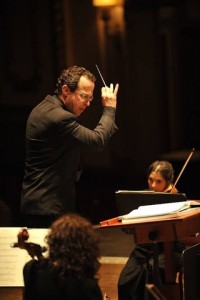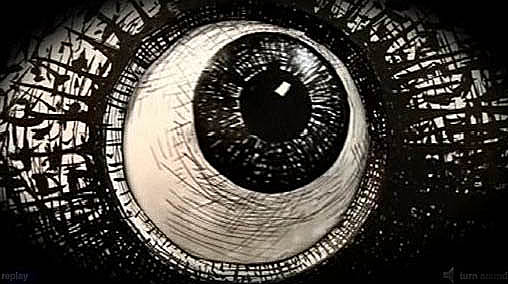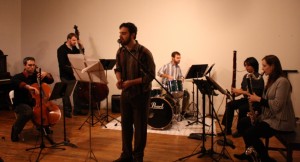[youtube]http://www.youtube.com/watch?v=z4SW9Zvtd9E[/youtube]
 While a fair amount of attention has been given to the American Composers Orchestra Underwood New Music Readings (namely here, here, here, here annnnd…here) which took place this past Saturday, Miller Theatre wasn’t the only place where new orchestral works were getting read & performed. Saturday was also the culmination of both the Albany Symphony‘s first annual Composer to Center Stage Festival Reading Session and their American Music Festival at the Experimental Media and Performing Arts Center at the Rensselaer Polytechnic Institute. As the spring semester at SUNY Fredonia was so kind to have come to an end, I decided to make the 6-hour drive up to Albany and check it out myself.
While a fair amount of attention has been given to the American Composers Orchestra Underwood New Music Readings (namely here, here, here, here annnnd…here) which took place this past Saturday, Miller Theatre wasn’t the only place where new orchestral works were getting read & performed. Saturday was also the culmination of both the Albany Symphony‘s first annual Composer to Center Stage Festival Reading Session and their American Music Festival at the Experimental Media and Performing Arts Center at the Rensselaer Polytechnic Institute. As the spring semester at SUNY Fredonia was so kind to have come to an end, I decided to make the 6-hour drive up to Albany and check it out myself.
The Reading Session featured works by three up-and-comers from the usual suspects of graduate programs: 200 OK by Robert Honstein (Yale), Siren Song by Wang Lu (Columbia) and In the Hour of Exile by Elizabeth Lim (Julliard). All three works demonstrated strong knowledge of the orchestra as an instrument and awareness of the various ingredients that seem to be common in today’s orchestral palette. The selection committee was smart to have chosen works with disparate styles – each piece had a completely different sound and color than the others. While each work was impressive in its own right, it was the Albany Symphony under the direction of its powerhouse conductor David Alan Miller that shone the brightest; I’ve conducted a fair amount of composer sessions myself, and Miller and the orchestra gave a textbook demonstration of how it should be done. 40 minutes were given to each composer’s piece and the metamorphosis from the first attempts to the final run-through of each work was really spectacular. Afterwards there was an insightful post-mortem out in the lobby with the participants, Miller, and the resident composers whose works would be performed that evening: John Harbison, Stacy Garrop, and James Primosch; it was great to hear discussion that not only covered technical issues, but explored the very idea of whether or not a chamber work may be suitable for orchestral treatment.
Just a few short hours later, the Symphony convened again in the hall to perform four works, including two world premieres and the live performance before a recording premiere. The Albany Symphony had already performed Garrop’s orchestral work Becoming Medusa in the fall as part of her year-long residency with the orchestra, and she explained how David Alan Miller had suggested the idea that the piece could act as the first movement of a symphony. The result of that suggestion was two movements that opened the concert – The Lovely Sirens (2nd mvt.), which had the woodwind Sirens enticing the sailors in the brass section to their bombastic doom, and The Fates of Man (3rd mvt.), which pitted a solo cello (representing Man) against the full forces of the orchestra (representing the three Fates), pleading for control of his existence…judging by the clever way the cello is kept from finishing its final idea, it’s not hard to figure out who won that debate.
James Primosch’s Luminism was based off of the Luminist style of Hudson River school of painters from the mid-19th century -another suggestion from David Alan Miller, who doesn’t seem to be afraid to give informed direction to his commissioned composers – and the Symphony did a fine job of balancing the Impressionistic ensemble writing and the various solos and duets that Primosch interspersed throughout the work. In preparation for a recording session the following day, Miller ended the program with John Harbison’s Gatsby Suite, which was created by yet another conductor suggestion, this time from David Zinman. A very effective distillation of his opera, the Suite features a period-style dance band (violin, soprano sax, trumpet, trombone, banjo, piano, tuba and drumset) within the middle of the orchestra, and the execution was seamless in the transitions between the two groups – this should get a lot of performances once the recording becomes available.
Overall, the adventure to Albany was an extremely enjoyable and informative one (I spent several hours in the car talking into my iPhone about ideas for new orchestral works). David Alan Miller is deserving of all the hype I’ve heard about him for years, and the orchestra made me realize that new music for orchestra is not a dead art at all, but one that needs able and interested performers to bring it to life. The concert (as well as previous concerts featuring music by Garrop, Harbison and Timo Andres) can be found at the Albany Symphony’s InstantEncore page (a site which seems to be gaining momentum in the few short years it’s been in existence).
Ken Ueno appeared with Joan Jeanrenaud at BAM last month. I missed the gig, but was excited to see the YouTube footage.
When I met Ken, in the graduate program at Boston University, he hadn’t yet started to sing; he was primarily a guitarist. Although he’s written a wide range of compositions, including Shiroi Ishi, a beautiful choral piece for the Hilliard Ensemble, in recent years he has carved out a distinctive identity as a throat-singer. Combining techniques from multiple traditions as well as some effects and ideas of his own, Ueno is now slugging it out toe to toe with Jeanrenaud!

You can hear more of Ken’s recent efforts, including a bunch of his throat-singing, on Talus, his disc for the BMOP/sound label.
The National Symphony Orchestra has been hosting composer John Adams over the past two weeks in presentations of his own works as well as works of the 20th century American, Russian and English repertoires. Last week he presented works by Copland, Barber, and Elgar as well as his own The Wound Dresser. This week, Adams and the NSO were joined by violinist Leila Josefowicz for a performance that included Adams’ electric violin “concerto,” The Dharma at Big Sur, and the Washington premiere of the Dr. Atomic Symphony.
The program began with Benjamin Britten’s “Four Sea Interludes” from his opera, Peter Grimes. While the opening “Dawn” interlude began on somewhat shaky ground, Adams quickly proved himself a capable conductor of this repertoire. The composer has been doing a lot of conducting over the past decade and it’s beginning to show. His confidence as a conductor, particularly one of pre-WWII 20th century music, has grown by leaps and bounds and the NSO’s playing under him reflected this. Whenever Adams conducts, however, he always presents his own work (it is part of the attraction, after all) and where in Britten and Stravinsky he is confident and capable, in his own work Mr. Adams is simply superb.
The Dharma at Big Sur, not so much a formal concerto for six string electric violin so much as a rhapsodic evocation of cross-country travel , California mythology, and the poetry and prose of Jack Kerouac. This is a powerful work, conveying a joyful energy that is simply infectious. The violin carries the bulk of the musical argument in the piece, with very few tutti moments offering rest from some highly energetic, virtuosic music, and Ms. Josefowicz astounds in her role as Kerouac’s musical manifestation. Her playing is a revelation and she simply OWNS this part. One hopes that she and Adams will come to record the piece sometime, not so much to replace the original 2006 recording with Tracy Silverman, the violinist for whom the work was written, but to complement it, as Ms. Josefowicz brings an exuberant energy to the piece that is just on the edge of wildness, where Mr. Silverman’s recording seems much more sedate by comparison.
After intermission, Mr. Adams and the orchestra took on Stravinsky’s early, slight orchestral showpiece, Feu d’artifice (Fireworks). They handled the work expertly, certainly, but it is a work that has failed to make much of an impression upon me through the years as little more than a youthful work by a composer on the verge of greatness. Indeed, the second half was really all about the Dr. Atomic Symphony, a reworking of material from Adams’ 2005 opera, Dr. Atomic. While the symphony obviously owes a great deal to the opera (and Adams, both in his speeches to the audience in between numbers and in the program notes, rather redundantly stressed the musical connections with the opera’s plot) it is certainly worthwhile as a free-standing work and does not really need any programmatic allusions to make its point. This is a harrowing symphony, full of a wild energy that proves the dark contrast to The Dharma at Big Sur’s sublime apotheosis, and the NSO and Adams gave it a duly appropriate reading which deservedly brought the house down. And while the symphony makes a visceral impression, it is also governed by a Sibelian formal logic that makes it an important addition to the somewhat dormant American symphonic tradition. It will hopefully prove to be one of Adams’ truly major works.
The National Symphony Orchestra, Leila Josefowicz, violin, under the direction of John Adams, will repeat this program on Friday, May 21 at 1:30 p.m. and Saturday, May 22 at 8:00 p.m. at the John F. Kennedy Center for the Performing Arts in Washington, D.C.
Congratulations to Joseph Rosenzweig, the first correct answerer to yesterday’s Ligeti question. Yes, Ligeti’s Poeme Symphonique is for 100 metronomes, and with that Mr. Rosenzweig & friend will be attending The New York Philharmonic’s May 27th production of Le Grand Macabre.
But there is still one more pair of tickets to give away, and one more question for some speedy answerer to, well, answer:
In 1986 Ligeti was an early winner of the prestigious Grawemeyer Award. For what work was it given?
Answers to: sequenza21@gmail.com
Will you be the first person e-mailing us the correct response? Will you be the lucky soul taking a friend for free to see this wonderful, riotous spectacle? Can there be any doubt it’s going to be you? — whoever you may be…
[Update: And that “you” turned out to be Whitney Ashe, the correct answer being Ligeti’s first book of piano Etudes. Congatulations Whitney, enjoy the show, and thanks to all you other readers for participating!]
[youtube]http://www.youtube.com/watch?v=PjN0reA5p84[/youtube]
 That was György Ligeti speaking about his opera Le Grand Macabre, in a 1978 interview with Herman Sabbe. Almost sounds sweet, doesn’t it? One little snag: to get to that end, you’re going to have to endure — or better yet, revel in — the hellish, absurd and grotesque. But Ligeti leads you through all this with a gleam, wink and half-smile, and the end result is a hellishly good time.
That was György Ligeti speaking about his opera Le Grand Macabre, in a 1978 interview with Herman Sabbe. Almost sounds sweet, doesn’t it? One little snag: to get to that end, you’re going to have to endure — or better yet, revel in — the hellish, absurd and grotesque. But Ligeti leads you through all this with a gleam, wink and half-smile, and the end result is a hellishly good time.
 Since its 1978 premiere Le Grand Macabre has had a wealth of performances all around the world; yet it’s only now that New York is getting its first full and fully-staged presentation. Three nights only, May 27 to May 29, at Avery Fisher Hall (Lincoln Center, NYC). The New York Philharmonic has quite a page devoted to the whole event with information on the full cast, all kinds of special information on the production, and plenty of preview sound clips. It’s also where you can buy tickets — except for a couple lucky couples…
Since its 1978 premiere Le Grand Macabre has had a wealth of performances all around the world; yet it’s only now that New York is getting its first full and fully-staged presentation. Three nights only, May 27 to May 29, at Avery Fisher Hall (Lincoln Center, NYC). The New York Philharmonic has quite a page devoted to the whole event with information on the full cast, all kinds of special information on the production, and plenty of preview sound clips. It’s also where you can buy tickets — except for a couple lucky couples…
That’s right, we here at S21 have been blessed with two pairs of tickets that we need to give away to some happy readers, for the Thursday May 27th performance . All you need to do is be the first person to email the correct answer to one of two questions, the second of which will come tomorrow, but the first of which is here right now:
There is a notorious piece by Ligeti, for 100 of the same ‘instrument.’ What is that instrument?
Answers to: sequenza21@gmail.com
If you miss out on this one, be watching for tommorrow’s post and your second question and chance. Good luck!

In Chicago? There’s a concert this week I wish I could attend — maybe you’ll be my proxy —
The Sissy-Eared Mollycoddles (named for a colorful bit of Ives invective), is a hub for an enthusiastic community of young Chicago performers and composers.
Their upcoming concert, “Ghost Towns,” will feature two premieres: Brian Baxter‘s mountainous Lulu City and Eric Malmquist’s take on the traditional Irish Folksong, The Wind that Shakes the Barley. Luke Gullickson’s epic Terlingua Meditations, Ben Hjertmann’s raucous Dakruvoso, and James Klopfleisch’s miniature for two violins, Cairn, round out the evening.
Thursday, May 20, 2010 7:30pm
Curtiss Hall, Fine Arts Building
410 S Michigan Avenue, 10th Floor
Chicago, IL 60605
$10 suggested donation at the door
Going to this concert? Leave a comment here and let us know what you thought!
I don’t normally quote press releases wholesale, but I don’t know what I could better in my own account (though be sure to read the last paragraph for some extra sweet deals). So…
……………….
On Thursday, May 20th, Metropolis Ensemble will present Home Stretch, in two performances featuring the compositions of composer/pianist Timothy Andres presented alongside two composers who have inspired his unique style: Wolfgang Mozart, and the father of ambient music, Brian Eno. Also featured will be the New York Premiere of Anna Clyne’s elegiac work for string orchestra, Within Her Arms. In keeping with Metropolis Ensemble’s mission to re-imagine the concert experience, each audience member will be handed a chair as they enter the Angel Orensanz Center and will be allowed to seat themselves where they like, giving them the opportunity to control their concert experience and to create a more social and interactive environment.
 Andres‘ piano concerto, Home Stretch, was written as a companion piece to Mozart’s K. 465. He explains that, “My last attempt at a piano concerto was when I was 15, and since then, I’ve mostly lost interest in the typical “virtuosity for its own sake” soloist versus orchestra dynamic of the genre. Luckily, the Mozart-sized forces led me to approach Home Stretch as chamber music, allowing for more subtle gestures and interplay between musicians.”
Andres‘ piano concerto, Home Stretch, was written as a companion piece to Mozart’s K. 465. He explains that, “My last attempt at a piano concerto was when I was 15, and since then, I’ve mostly lost interest in the typical “virtuosity for its own sake” soloist versus orchestra dynamic of the genre. Luckily, the Mozart-sized forces led me to approach Home Stretch as chamber music, allowing for more subtle gestures and interplay between musicians.”
For the concert Andrew Cyr, Metropolis Ensemble’s Artistic Director/Conductor, asked Andres to write music to pair with Home Stretch, which led to Brian Eno: Paraphrase on themes of Brian Eno. Andres remarks that, “I immediately thought of the spacious, static opening section of Home Stretch and the huge debt it owes to Eno’s harmonies and timbres. The result is a 19th-century style “orchestral paraphrase” on the subject of Eno’s music, focusing on the albums Before and After Science and Another Green World, with some Apollo by means of an introduction.
Much of the solo part of, Piano Concerto No. 26 “Coronation”, one of Mozart’s most popular concertos, was left unfinished by the composer. Inspired by the conception of music as a living art form, Metropolis Ensemble has commissioned Andres to compose new music for the left hand part as well as an entirely new solo cadenza to be performed on the evening concert by Andres.
 Anna Clyne‘s Within Her Arms was a 2009 commission from Esa-Pekka Salonen as part of the Los Angeles Philharmonic’s Green Umbrella series. Metropolis Ensemble presents the New York Premiere of this work for string orchestra. Within Her Arms, dedicated to Clyne’s mother, brings to mind the English Renaissance masterpieces of Thomas Tallis and John Dowland.
Anna Clyne‘s Within Her Arms was a 2009 commission from Esa-Pekka Salonen as part of the Los Angeles Philharmonic’s Green Umbrella series. Metropolis Ensemble presents the New York Premiere of this work for string orchestra. Within Her Arms, dedicated to Clyne’s mother, brings to mind the English Renaissance masterpieces of Thomas Tallis and John Dowland.
 Also, only on the afternoon concert’s bill, Andrew Norman‘s work for eight virtuoso violins, Gran Turismo. Norman writes: “Rewind my life a bit and you might find a particular week in 2003. I was researching the art of italian Futurist Giacomo Balla for a term paper, watching my roommates play a car racing video game called Gran Turismo, and thinking about the legacy of Baroque string virtuosity as a point of departure for my next project. It didn’t take long before I felt the resonances between these different activities, and it was out of their unexpected convergence that this piece was born.”
Also, only on the afternoon concert’s bill, Andrew Norman‘s work for eight virtuoso violins, Gran Turismo. Norman writes: “Rewind my life a bit and you might find a particular week in 2003. I was researching the art of italian Futurist Giacomo Balla for a term paper, watching my roommates play a car racing video game called Gran Turismo, and thinking about the legacy of Baroque string virtuosity as a point of departure for my next project. It didn’t take long before I felt the resonances between these different activities, and it was out of their unexpected convergence that this piece was born.”
……………….
Remember now, we’re talking two concerts, both on Thursday, May 20: at 1pm, Trinity Wall Street (79 Broadway), and again at 8pm at the Angel Orensanz Center (172 Norfolk Street). The afternoon gig is FREE, but click here for an RSVP or tickets to the evening gig. And that’s not all, folks: “This project has been in the works for two years and coincides with the Nonesuch release of Andres’ new CD Shy & Mighty. We will be running a promotion at Timo’s CD launch event at Le Poisson Rouge on Monday, May 17. Anyone who buys a ticket for the Thursday night concert at the event on Monday will receive a free copy of Shy and Mighty. We would also like to extend a special offer to readers of Sequenza21: we would like to offer 2 for 1 general seating tickets with the code sequenza21“.
